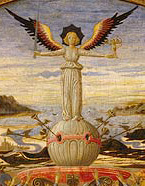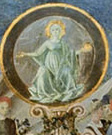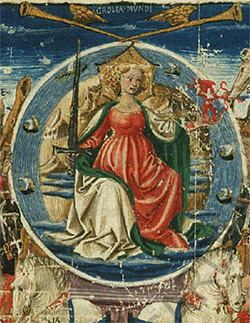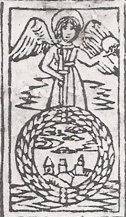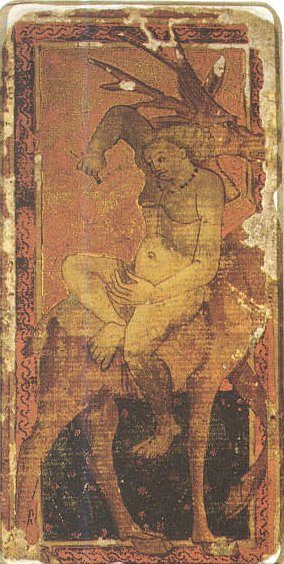Hi Michael, Huck,
If the images don’t convince you of the iconographic identification of the figure, I doubt my arguments will be able to.
The following three figures represent the same subject, a "Triumph of Fame" -
The come from the same place, and were painted within 11 years (or less) of one another - 1449-1460. They all show a subject with the same title, but each is slightly (or even very) different. The first is a stand alone Triumph, not part of a cycle of Petrarch's Trionfi; the second and third are illustrations of the Trionfi. The second one, by Francesco Pesellino, apparently owes some of its features to the description of the figure by Boccaccio in Amorosa Visione, chap. VI (the golden apple, two captives, and World behind her, for instance). But the sword Boccaccio describes is missing.
The other two have a sword and a cupid (or at least, a red archer). Of course, the most outstandingly different feature of the first Fama is that she has wings and stands upon a globe, with the world depicted all around her. All are adequate interpretations of the theme, although different, and we don’t need to guess what the theme is – it is explicit.
Comparing the Rosenwald world card with the Lo Scheggia’s Fama,
We see a strikingly similar figure (of course in the Rosenwald the halo is *round*, different from the Virtues on the same sheet. Given the differences among explicit and exactly contemporary Fama images, arguing that the shape of the halo changes the essential meaning of the figure seems arbitrary). My point is that Fame IS “Gloria Mundi”, and Gloria Mundi is the World. That is, Gloria Mundi is the meaning of the card in the early A sequences – it is the highest possible Fame, transcending death and going to the height of heaven, but it is vanquished by the “Last Trump” of the Angel, announcing Eternity.
Understanding the figure on the various early cards of the southern type as Gloria Mundi explains both the traditional title of the card, its meaning in the sequence, why it might be appropriate in a series of images known as “trionfi”, and most importantly, the visual aspect – the iconology – of the image itself.
mjhurst said:
In fact, despite all our rummaging around in the obscure world of polygonal halos, essentially NOTHING has changed. We had the facts right from the beginning, as they apply to Tarot, despite having learned a great deal about things other than Tarot.
I’ve also concluded that that shape of the halo is irrelevant, although its presence is a clue to its provenance and date.
This is a Tarot deck, not Petrarch's Triumphs, and the World card is NOT the only figure in this work with such a halo. Your argument fails twice.
The first is a strawman. I never argued the tarot “is” Petrarch’s Triumphs (in fact I explicitly rejected that proposal here just recently) – nor Boccaccio’s Amorosa Visione, nor a Children of the Planets, nor anything but a game of cards with a series of trumps that tell their own story, and that story had to be recognizable to people who played with them in order to know the hierarchy correctly.
But that the imagery on the cards is informed by – borrowed – from other contemporary imagery, it seems unnecessary to mention. The Bagatto does in fact seem to be borrowed from the Children of the Planets, and the World (and Love, the Old Man, and Death) does seem to borrow from images of Petrarch’s Triumphs.
For the second point, I don’t think the halo, either its presence or shape, is enough to overturn the conventional depiction of the subject.
Both Prudence and Fama usually have other attributes, which are not shown in the Charles VI World card. This depiction is going to be unique in one way or another, so some additional argument must be developed; an argument pertaining to this deck.
The image has enough attributes of Fama in the range of contemporary depictions and descriptions to be confidently identified with her. She has not a single attribute of Prudence (neither a mirror, nor a snake, nor two faces). A halo alone can’t identify a figure as a Virtue, when everything else says something else.
Instead of comparing it just to Petrarch's Triumphs,
Did you see Weisbach’s reference to Boccaccio? And the passage in question? This informs the visual aspect of the image more than Petrarch’s poem.
we can compare it to other Tarot decks. We have decks in which both the virtues and Fama appear, and the virtues are given the polygonal halo.
Maybe you haven’t expressed yourself clearly here, but I don’t know of any decks where the virtues have polygonal haloes and Fama (explicitly so called) also appear. The only other deck I know with polygonal haloes is the Rosenwald, and there is no Fama in there, unless you are implicitly admitting my thesis.
In any case, we are on the same page with regards to the iconological significance of the polygonal halo – nadda. All it has taught me (and it has been the most valuable insight) is that other types of triumphs from the same time and place used it for the personifications of Fama, aka Gloria Mundi.
Does Fama wear the polygonal halo in those decks? Does Fama replace the World in those decks?
I’m not sure the decks I think you are thinking of have much relevance to the mid-15th century ones we are considering.
Do you have any example of any work ever where Fama is shown with a polygonal halo alongside virtues with the same attribute?
Do you have any examples of Prudence even vaguely similar this to card? Do you really think the shape of a halo is enough to overturn the commonsense interpretation of all of the other features of the image?
Having a Fama at this point in a deck of Triumphs is not a difficult thing to explain in the narrative (my narrative of the trumps, of course). It is in fact a deck of “Triumphs”, and this is the highest possible Triumph, except for God (maybe better said - this is obviously the highest possible Triumph in the A sequence designer's mind, except for the Trumpet announcing the resurrection to Eternity).
It seems that Shephard has by far the best of this argument. (He makes a lot of lame arguments, so it's good to point out one where he got it right.) We need to first look to the work in question. In that work the three Moral Virtues are shown with a polygonal halo, and also given such an attribute is a woman with attributes of sovereignty on the World card. There is an obvious conclusion, based on the use of polygonal halos on virtues and on Fame in other decks and other works. The figure is certainly not Fame, and the figure is almost certainly Prudence.
I don’t think so. It was an ad hoc argument when he made it, and he wasn’t perfectly sure of it either. But I noticed that in her discussion of the various Mondo images in 1987, Claudi Cieri-Via already noted that the Charles VI Mondo reflects the conventional depictions of Fama and Gloria Mundi. Vitali picks up the theme too, but neither gives the illustrations to make the point. Also, no one yet suspected the Florentine origin of the cards, and all the similar depictions of the Triumphal figure of Fame are Florentine.
The most important thing, it seems to me, is that the figure of Fame, in this tradition at this time, has a WORLD.
In some early makers the figure gets minimized (Este), in other later ones, the World gets minimized or even obliterated (TdM) in favor of the figure (I'm not arguing meaning here, just appearance and descent; but it seems the original figure had to have a World on it to make any sense in the tradition).
Best regards,
Ross

